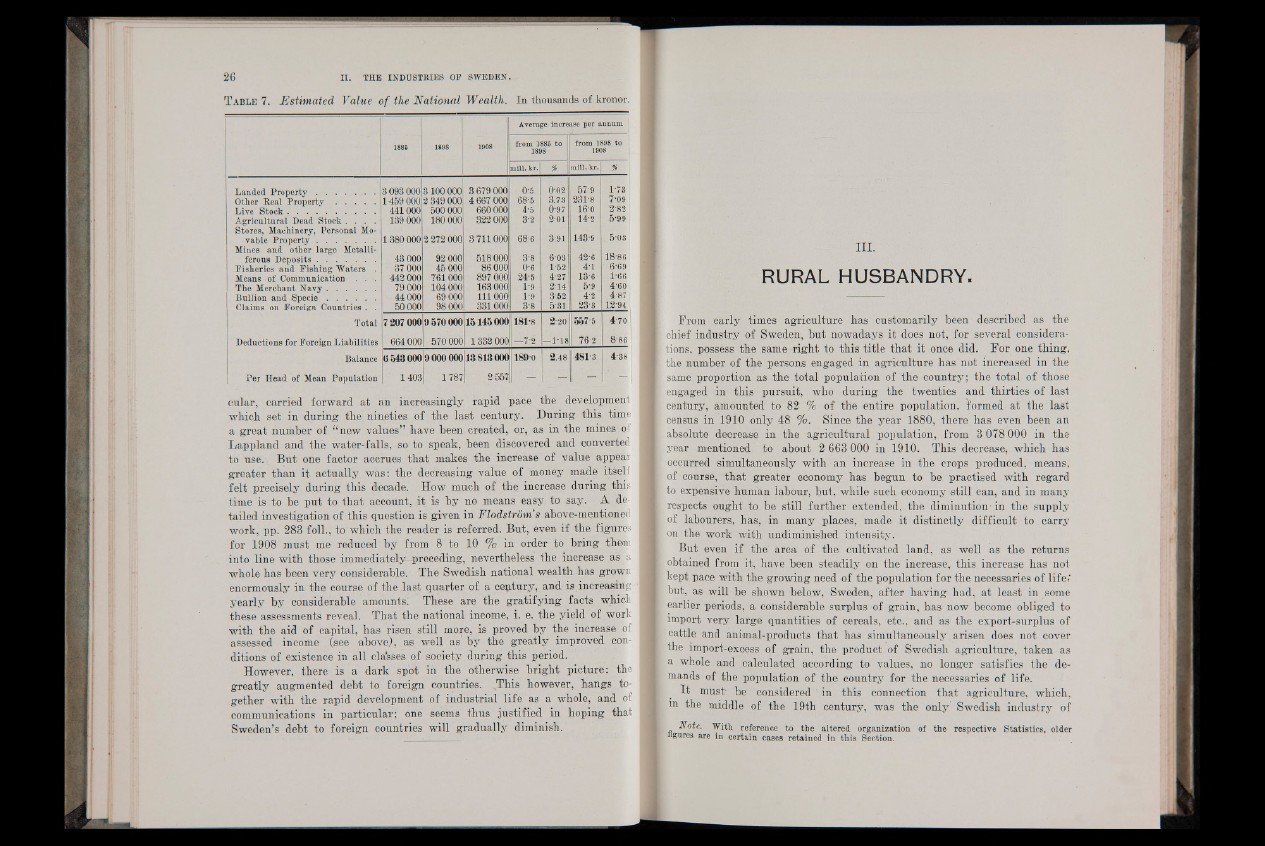
T able 7. Estimated Value of the National Wealth. I n thousands of kronor.
Average increase per annum
1885 1898 1908 from 1885 to
1898
from 1898 to
1908
mill. kr. % mill. kr. % n
Landed P ro p e r ty ........................
Other Real Property . . . . .
Live Stock ....................................
Agricultural Dead Stock . . . .
Stores, Machinery, Personal Movable
P ro p e rty ........................
Mines and other large Metalliferous
Deposits . ....................
Fisheries and Fishing WaterB .
Means of Communication . . .
1 The Merchant Navy....................
Bullion and S p e c ie ....................
Claims on Foreign Countries . .
3100 000
2 349 000
500 000
180 000
2 272 000
92 000
45 000
761000
104000
69000
98 000
3093 000
1459000
441000
139 000
1380 000
43 000
37 000
442 000
79 000
44 000
50 000
0-5
68-5
45
3-2
68-6
3-8
0-6
24-5
1-9 •
1'9
1 3'8
3 679 000
4 667 000
660 000
322 000
3 711000
518 000
86 000
897 000
163 000
111 000
331000
0-02
3.73
097
2-01
3-91
603
1-52
4-27
2-14
3'52
5-31
57-9
231-8
16-0
14-2
143‘9
42-6
41
13-6
- 5-9
4-2
23-3
1-73
7-09
2-82
5-99
5-03
18-86
6-69 [
1 -66:
4-60 j
4-87
12-94 1
Total 7 207 000 9 570000 15145 000 181-8 2-20 557*5 4-70
Deductions for Foreign Liabilities 664 000 570 000 1332 000 1—7-2 —1-18 76-2 8-86
Balance 0548 000 9 000000 13813000 1189-0 2.48 481-a 4-38
Per Head of Mean Population 1403 1787 2 557 | - ■ 1 M 1
cular, carried forward at an increasingly rapid pace the development
which set in during the nineties of the last century. During this time
a great number of “new values” have been created, or, as in the mines ol
Lappland and the water-falls, so to speak, been discovered and converted
to use. But one factor accrues that makes the increase of value appear
greater than it actually was: the decreasing value of money made itself
felt precisely during this decade. How much of the increase during this
time is to be put to that account, it is by no means easy, to say. A detailed
investigation of this question is given in Flodstrom s above-mentioned
work, pp. 283 foil., to which the reader is referred. But, even if the figures
for 1908 must me reduced by from 8 to 10 % in order to bring them
into line with those immediately-preceding, nevertheless the increase as. a
whole has been very considerable. The Swedish national wealth has grown
enormously in the course of the last quarter of a ceptury, and is increasing
yearly by considerable amounts. These are the gratifying facts which
these assessments reveal. That the national income, i. e. the yield of work
with the aid of capital, has risen still more, is proved by the increase of
assessed income (see above), as well as by the greatly improved conditions
of existence in all claisses of society during this period.
However, there is a dark spot in the otherwise bright picture: the
greatly augmented debt to foreign countries. „This however, hangs together
with the rapid development of industrial life as a whole, and of
communications in particular; one seems thus justified in hoping that
Sweden’s debt to foreign countries will gradually diminish.
III.
RURAL HUSBANDRY.
From early times agriculture has customarily been described as the
chief industry of Sweden, but nowadays it does not, for several considerations,
possess the same right to this title that it once did. For one thing,
the number of the persons engaged in agriculture has not increased in the
same proportion as the total population of the country; the total of those
engaged in this pursuit, who during the twenties and thirties of last
century, amounted to 82 % of the entire population, formed at the last
census in 1910 only 48 %. Since the year 1880, there has even been an
absolute decrease in the agricultural population, from 3 078 000 in the
year mentioned to about 2 663 000 in 1910. This decrease, which has
occurred simultaneously with an increase in the crops produced, means,
of course, that greater economy has begun to be practised with regard
to expensive human labour, but, while such economy still can, and in many
respects ought to be still further extended, the diminution'in the supply
of labourers, has, in many places, made it distinctly difficult to carry
on the work with undiminished intensity.
But even if the area of the: cultivated land, as well as the returns
obtained from it, have been steadily on the increase, this increase has not
kept pace with, the growing need of the population for the necessaries of life;
but, as will be shown below, Sweden, after having had, at least in some
earlier periods, a considerable surplus of grain, has now become obliged to
import very large quantities of cereals, etc., and as the export-surplus of
cattle and animal-products that has simultaneously arisen does not cover
the import-excess of grain, the product of Swedish agriculture, taken as
a whole and calculated according to values, no longer satisfies the demands
of the population of the country for the necessaries of life.
It must- be considered in this connection that agriculture, which,
in the middle of the 19th century, was the only Swedish industry of
Note. With reference to the altered organization of the respective Statistics, older
ngures are in certain cases retained in this Section.